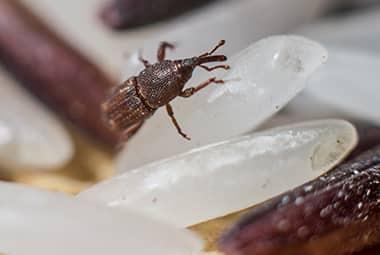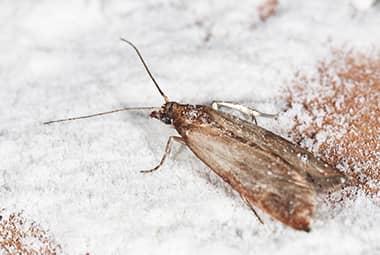There are several pests that like to get into pantry foods. These are called stored product pests or cereal pests because they target products that are stored and many have a fondness for foods that have grains in them. Perhaps you’ve heard of some pantry pests. Does the Indian meal moth, the saw-toothed grain beetle, or the rice weevil ring a bell? There are several species of beetle and weevil that get into stored foods. When they do, they lay their eggs so that developing larvae have easy access to a food source when they hatch. Unfortunately, that can make your foods less than savory. Here are some of the best tips for avoiding stored product pests this summer, from the experts at Russell’s Pest Control.
Identification
The best way to stop this type of pest from getting into your home is to recognize signs of infestation. In the case of Indian meal moths, these tiny, rusty-brown colored moths only live for a short period of time because they aren’t able to eat. At this stage of development, those adults can give you a warning sign that larvae are in the foods these moths are found near. This is also the case with beetles and weevils. If you see insects, pay close attention.
Inspection
When you’re selecting foods from the grocery store, inspect the packaging. Do not purchase any products that have holes, gaps, or rips that pantry pests can use to get in.
Early Detection and Product Protection
The best way to detect pantry pests and prevent the spread of pantry pests from one product to the next is to put your foods in sealed plastic containers. When you do this, it will also give you the opportunity to inspect your foods. Look for the presence of webbing and, of course, tiny insects crawling around.
Good Practices
If you don’t use sealed plastic containers to protect your food, take steps to prevent food spoilage that can attract pests in from the outside of your home. Put new items to the back and old items to the front. Routinely check your due dates and throw out old items. Keep shelves clean and free of food debris.
Pantry Pest Control
When pantry pests appear, contact a licensed and certified pest professional. Throwing out the tainted product is not a guaranteed way to solve your problem, and if pantry pests are allowed to continue to feed on your foods and spread in your pantry, you could have a big problem on your hands.
For assistance with all pest problems in the Greater Knoxville area, contact Russell’s Pest Control. We have the licenses, certifications, and reputation for arresting pest problems.


